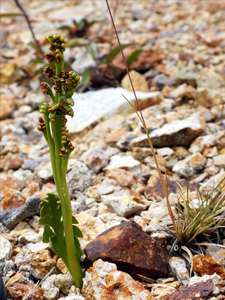The Colorado Natural Areas Program is the only program within state government that has an emphasis on rare plant conservation.
Conservation in Colorado
Colorado ranks 13th for plant diversity and 8th for the most plant species at risk.
There are 117 plant species in Colorado considered to be globally imperiled and vulnerable of extinction. Of those, 68 species are found only in Colorado, and nowhere else in the world. These species are often narrowly distributed and restricted to a specific habitat, making conservation of their small footprint across the state (62,500 acres or <0.001% of the state) a very important goal.
There are 16 plant species in Colorado currently listed as threatened or endangered under the Federal Endangered Species Act, with several more species under review by the US Fish and Wildlife Service (USFWS).
Conservation Highlights
 CNAP undertakes and supports targeted surveys to identify new populations of rare plants, the collection of quantitative data on rare plant population trends, and observational data collection on known rare plant element occurrences.
CNAP undertakes and supports targeted surveys to identify new populations of rare plants, the collection of quantitative data on rare plant population trends, and observational data collection on known rare plant element occurrences.
Over 80% of Colorado’s Designated Natural Areas include at least one rare plant species, and more designations to protect rare species are being developed.
CNAP supports education about rare plants through funding for the Colorado Natural Heritage Program’s
Rare Plant Guide.
CNAP was a partner in the development of the
Rare Plant Conservation Initiative, a consortium of many stakeholders to create a unified statewide strategy for rare plant conservation.
CNAP partnered with The Nature Conservancy in 2007 to acquire the Wacker Ranch, near Montrose, in order to protect a significant portion of the largest and most viable population in the world of the federally endangered clay-loving wild buckwheat (Eriogonum pelinophilum). This conservation action helped this endangered species become a step closer to recovery under the federal Endangered Species Act.
CNAP has partnered with Oxy USA for over 25 years to conserve the federally threatened Parachute penstemon (Penstemon debilis). Using voluntary cooperative conservation agreements, CNAP continues to build on the partnership with Oxy to protect the federally-listed plant on private lands, while responsibly development energy resources using best management practices for rare plants.
Accomplishments
Colorado State Wildlife Action Plan Rare Plant Addendum
 CNAP was a major player in the Rare Plant Conservation Initiative’s development of the Rare Plant Addendum for the Colorado State Wildlife Action Plan (SWAP). This document, which includes a “collective vision for plant conservation in Colorado” was recently updated and included in the 2015 Revised Colorado State Wildlife Action Plan.
CNAP was a major player in the Rare Plant Conservation Initiative’s development of the Rare Plant Addendum for the Colorado State Wildlife Action Plan (SWAP). This document, which includes a “collective vision for plant conservation in Colorado” was recently updated and included in the 2015 Revised Colorado State Wildlife Action Plan.
View the statewide strategic direction for the conservation of Colorado’s most imperiled plant species and lists of Tier 1 and Tier 2 Plant Species of Greatest Conservation Need in the
Rare Plant Addendum. Colorado has no state statute protecting rare plants, and therefore no list of state threatened and endangered plant species.
Colorado Roadside Globally Imperiled Plants Best Management Practices
CNAP has partnered with the Colorado Natural Heritage Program (CNHP) and Colorado Department of Transportation (CDOT) to develop recommended Best Management Practices for globally imperiled plants known from roadside locations in Colorado. See the links on our CNAP News and Resources page for documents with recommended BMPs for specific rare plant species.
Sources for Plant Identification and Information

